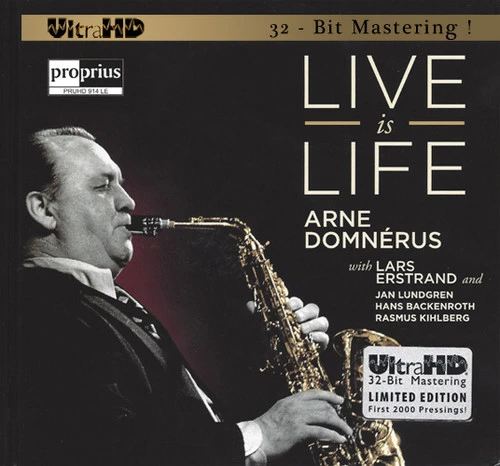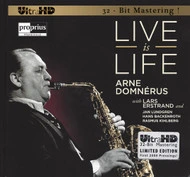 Click Here for Sound Samples!
Click Here for Sound Samples!  Out of Print! Limited Supplies!
Out of Print! Limited Supplies! This album should be titled "Jazz at the Club Doppingen!" If you love and appreciate Jazz At The Pawnshop, like we do, then you MUST own this album!!
This Ultra HD 32-bit Mastering CD has the same great sound quality as Jazz At The Pawnshop, the same two soloists Arne Domnerus and Lars Erstrand, same engineer, same mikes, etc. It's basically "Jazz at the Club Doppingen!"
Limited Run of Only 2,000 First Edition Pressings Available for Optimal Sound Quality!!!
Ultra High Definition 32-Bit Mastering!
This Ultra HD 32-Bit Mastering CD will play on ALL CD players!
Arne Domnerus is joined by fellow musicians Lars Erstrand, Jan Lundgren, Hans Backenroth, and Rasmus Kihlberg. This music was recorded live in 1995 at the Club Doppingen in Uppsala, a city 43 miles north of Stockholm (where Jazz At the Pawnshop was performed and recorded). Live Is Life was recorded by Gert Palmcrantz (who also recorded Jazz At the Pawnshop) with the famous Didrik De Geer Microphones.
Historic Session 1976:
During two dark evenings in December 1976 Gert Palmcrantz rigged his few, but well-placed, microphones in the legendary Pawnshop jazz club in Stockholm. On stage were the two master musicians Arne Domnerus and Lars Erstrand, backed by a renowned and exceptionally swinging trio: Bengt Hallberg, Georg Riedel and Egil Johansen. The result of these winter nights soon resounded the world over. The live recording Jazz at the Pawnshop sold nearly 200,000 records! Even in the far distant East Asia this superb live recording has found a vast audience. In essence, the producer Jacob Boethius, of the quality-minded little record company Proprius, has been able to chalk up a genuine best-seller of Swedish jazz.
Here We Go Again In 1995:
After almost two decades it's time again. One evening, in April 1995, sound maestro Gert Palmcrantz sets up his hi-dynamic Didrik de Geer-microphones at the Club Doppingen in Uppsala. Proprius' Jacob Boethius has once more given the go ahead to a live recording of some of his most favorite musicians. Featured soloists are the same as last time, in other words: Arne Domnerus and Lars Erstrand. The back-up trio on the other hand is new and consists of three very talented young musicians: Jan Lundgren, Hans Backenroth and Rasmus Kihlberg. Just as twenty years earlier, the live audience found that good music is always characterized by one special thing: it is personal, genuine and uncompromising. It's refreshingly satisfying to the listener. It gives your spirit a boost. Live is life is a CD that, like its predecessors Jazz at the Pawnshop 1-3, brings the listener true joy and an enhanced zest for life. It's remarkable how good music possesses such potent power.
Live Is Life:
Far too seldom is music recorded when it's performed at its most spontaneous, i.e. during a concert. Strangely enough even jazz--in spite of this form of music being by its very improvising nature so markedly inspired by the moment. Live is life offers us as listeners generous opportunity to enjoy the music directly and close-up, without retakes and post-editing. Moreover, at a live recording that audience contributes its immediate response. How telling an applause can be! A cool and polite reception or a warm and enthusiastic ovation? Applause is revealing. On Live is life there's no question about the audience's feelings. Which naturally makes the musicians give their utmost. The give and take in a live recording situation truly mirrors the interaction of life.
Guide and Trailblazer:
Arne Domnerus at seventy shows no sign of letting up in creating and forming music according to his own inner voice. Soulful, convincing, with a never ending flow of ideas, as well as a very personal sound and a keen sense of timing, he has been, for as long as five decades, a guide and trailblazer in Swedish jazz. His unique ability to freely alternate between the alto sax and the clarinet maintaining quality is solid proof that his talent is innate. Else this can't be done. For the last few years Domnerus is taking great pleasure in being confronted by the youngest and more gutsy jazz musicians. A way of staying young at heart, he says. But also a way of transferring knowledge, insight and maturity to those, who one day will have to carry on the tradition. On Live is life there's quite plainly a candidness and sincerity bridging the generation gap. The music reflects warm friendship, but also mutual respect, with a touch of mischief and biting humor--in other words: the kind of kibitzing that's part of all stimulating relationships. When Domnerus, during a relaxed break, mentions that he is "old enough to be the father of the young ones in the rhythm section," the twenty-nine year old Jan Lundgren at once replies that it's not so. "More likely the grandfather..."
Distinguished Band Members:
Pushing sixty, Lars Erstrand is nowadays reckoned among the gray beards of Swedish jazz. For a long time he is the unchallenged maestro of vibraphone nationally, but even abroad it's hard to find his equal. The qualities of Lars Erstrand's musicianship are many: not least his obvious sense of harmony combined with technical skill and unfailing rhythm. Moreover, he is a very sensitive interpreter of ballads. Among the encouragingly promising generation of young and upcoming new musicians Jan Lundgren belongs to the more aggressive. His playing attests to a solid knowledge of jazz history, while at the same time his strong will to chart his own course is clearly discernible. Jan Lundgren's ability to raise the temperature of a session is only one of his many virtues. Others are his good taste and exquisite touch. A good bass player must be driving as well as supportive. Hans Backenroth possesses both of these qualities. He is also skillful soloist able to accomplish exciting musical lines in a highly enjoyable manner. It is easy to appreciate the mellow and perfect sound of Hans Backenroth's double bass. All good jazz is based on a fundamental rhythmic energy. Rasmus Kihlberg has a natural feel for swing in his drumming. He is attentive to what's happening, enabling him to push the soloists when needed. Rasmus Kihlberg is yet another inspiring representative of young Swedish jazz.
Ultra High Definition 32-Bit Mastering!
Ultra High Definition 32-Bit Mastering is a proprietary ultra-high-quality mastering system. This leading-edge system has achieved unprecedented sonority and musicality, reproducing as closely as possible the sound of the original master tape! This format employs what is currently the highest attainable resolution bit depth (word length) in the professional audio field, i.e. 32-bit. 32-bit resolution makes possible maximized, undistorted dynamics, and the lowest noise floor, allowing even the quietest musical information to be heard more clearly. This breakthrough results from the development, through years of experience and application of advanced digital technology, of a sophisticated A/D and D/A processing system.
Ultra HD 32-Bit Mastering does not specify a sampling rate; this allows flexibility in meticulously choosing the appropriate bandwidth for a particular recording. The higher the sampling rate -- for example, 192 kHz -- the greater the bandwidth. However, merely employing the greatest bandwidth may not guarantee the ultimate sound. With some recordings, a lower sampling rate -- 96 or 176 kHz -- may offer better musicality and more homogeneous harmonics. This determination requires careful and discerning auditioning and professional judgment. In the end, the human beings hearing and emotions should be the final arbiter, rather than the print-out of testing equipment or technical measurements.
Recognizing these variables, FIM nevertheless tries to use 32-bit depth and 192 kHz bandwidth whenever the original analog master is at hand. Alternatively, if the original recording is on 24/96, the 32/96 may eventually be used to maintain the integrity of the sonority particular to that recording. With this flexibility, First Impression Music believes that preeminent sound is only achievable when the chemistry of the recording, mastering, glass-stamper making, replication, and quality control is right. As always, listening is believing.
This recording has been mastered by the new Ultra High Definition 32-Bit Mastering process, which creates an unbelievable sound surpassing other formats!
The benefits of Ultra HD 32-Bit Mastering:
Ambience of Analogue Sound
Higher Resolution
Undistorted Dynamics
The Lowest Noise Floor, allowing even the quietest musical information to be heard more clearly!
Richer Sound Field
Master-Tape Quality Sound!!!
Delivers what musicians originally intended!
Features:
Limited Run of Only 2,000 First Edition Pressings Available!
Ultra HD Mastering
Beautifully packaged
Playable on ALL CD Players!
Musicians:
Arne Domnerus, saxophone, clarinet
Lars Erstrand, vibraphone
Jan Lundgren, piano
Hans Backenroth, bass
Rasmus Kihlberg, drums




 Turntable Accessories
Turntable Accessories Headphone Accessories
Headphone Accessories Cable Accessories
Cable Accessories Vinyl Accessories
Vinyl Accessories Compact Disc Accessories
Compact Disc Accessories







